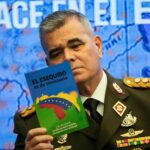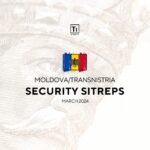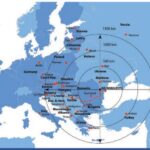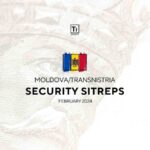A covert US airstrike has killed the leader of Tanzeem Hurras al-Din (HAD), al-Qa’ida’s leading Syrian franchise, in Idlib province on 14 June 2020. Abu al-Qassam (also known as Khaled al-Aruri) was a seasoned al-Qa’ida (AQ) operative who was plotting attacks against the West.
According to social media sources, an MQ-9 Predator drone armed with AGM-114 Hellfire missiles, likely operated by the Central Intelligence Agency (CIA) or Joint Special Operations Command (JSOC), was present over Idlib that day.
#شاهد
رصد طائرة مسيرة تتبع للتحالف الدولي بعد استهدافها سيارة نوع سنتفيه في مدينة #إدلب ما أدى لمقتل شخص وإصابة آخر..
رابط يوتيوب …https://t.co/r8FAILRmP2 pic.twitter.com/FyCl8l5j0u— سعد الدين زيدان (@Saadalzydan) June 14, 2020
Impact marks on the target vehicle, blade cuts, and ordnance debris suggest that the US employed the secretive, blade-wielding derivative of the AGM-114 Hellfire, known as the R9X.
Geçtiğimiz günlerde İdlip’te bir araca yönelik saldırıda kullanılan AGM-114 Hellfire Füzesine (Ninja Füzesi) ait parçaların görüntüleri. @orko_8 @Acemal71 @hkilichsword2 https://t.co/3lJOIWgxcO pic.twitter.com/6EoYjAWlK1
— Turkey In The World (@TRintheworld) June 17, 2020
AGM-114R9X HELLFIRE AKA THE “FLYING GINSU”
While the United States never officially acknowledged its existence, the R9X is an open secret. The R9X trades the “Hellfire” warhead for six sword-like blades that eject upon impact and slice the target into pieces. Because there is no explosion, the weapon minimizes collateral damage.
geolocation https://t.co/VyquiabgdP https://t.co/64yEDJyDIC pic.twitter.com/qX4J8ZKVFa
— Samir (@obretix) June 14, 2020
The R9X debuted in February 2017, when it neutralized AQ deputy commander Abu Khayr al-Masri near al-Mastouma in Idlib province. Since then, JSOC and the CIA have repeatedly used the weapon against high-value targets in northwestern Syria, Afghanistan, and reportedly the Horn of Africa.

R9X schematic via The Wall Street Journal
WHY IS THE US TARGETING TANZEEM HURRAS AL-DIN (HAD)?
Tanzeem Hurras al-Din (HAD, or “Guardians of the Religion Organization”) was founded in February 2018, when a group of AQ loyalists splintered from Hay’ at Tahrir al-Sham, the most influential terrorist group in Idlib. The hardliners left because HTS publicly cut ties with AQ central.
Now AQ’s leading Syrian franchise, HAD aims to overthrow the Syrian regime and establish a regional Islamic State. In contrast to HTS, HAD is outspoken about its intent to attack the United States and the West.
Tanzim Hurras Al-Din fighters on #Hama, #Aleppo and #Latakia front line. pic.twitter.com/RrAmnIJYjd
— NoaDeVries (@denoavries) December 29, 2018
Despite its malign intentions, international observers and the press often overlook HAD. According to a UN intelligence report, HAD’s numbers are currently small (between 1,500 and 2000 fighters), the group exercises little territorial influence and depends on HTS funds to operate.
In the long term, HAD could nevertheless establish itself as a more radical alternative to HTS. While HTS cooperates with Turkey on the Sochi peace process, HAD opposes negotiations with the “infidels.” HAD favors a full-out confrontation with the pro-government forces. Part of this strategy is to mobilize the Syrian opposition under its wing and AQ banner.
COUNTERING AL-QA’IDA IN SYRIA (AQ-S)
The United States intelligence and military collectively refer to HAD, HTS, and other ex-Jabhat al-Nusra groups as al-Qa’ida in Syria (AQ-S). Despite their different policies and marketing strategies, the jihadi groups are still cooperating to achieve AQ’s global agenda.
In response to the growing terrorist threat in northwestern Syria, the US has deployed kinetic options to weaken AQ-S groups. The campaign began in 2014, when American drones targeted the Khorasan Group, then Ahrar al-Sham and Jabhat al-Nusra. The operational tempo increased in 2019. American drones prosecuted four targets: A HAD training camp in June, a HAD safehouse in August, a foreign trainer of the “Red Bands” (HTS’ special forces) in December, and a car carrying Ahrar ash-Sham members later that month.
With the latest strike on 14 June 2020, it becomes clear that HAD has absorbed the lion’s share of US airstrikes in Idlib. The focus on HAD indicates that Washington is increasingly concerned about the group’s intentions to attack the West.
Intelligence suggests that HAD has recruited ISIS fighters who escaped from the siege on Baghuz al-Faqwani – diehards with extensive combat experience, and possibly networks of terrorist cells. HAD fighters also enjoy a fast gateway to Europe and other locations in the Middle East, due to their proximity to Turkish territory. Likely, the reduction of violence in Idlib has given HAD breathing space to build external terrorist networks and plan strikes against the West.
Defeating HAD will require close coordination with Turkey, which de facto patrons Idlib province, and supports HTS, HAD’s “frenemy.”
by HARM
Editing by Gecko
Founder of T-Intelligence. OSINT analyst & instructor, with experience in defense intelligence (private sector), armed conflicts, and geopolitical flashpoints.





